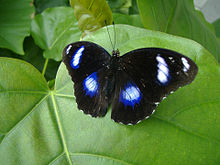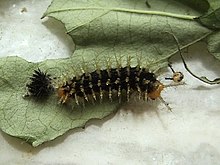Hypolimnas bolina: Difference between revisions
Stemonitis (talk | contribs) m typos |
Nilupulcool (talk | contribs) No edit summary |
||
| Line 83: | Line 83: | ||
==External links== |
==External links== |
||
*[http://www.wildreach.com/butterflies/Hypolimnas_bolina.php Sri Lanka Wild Life Information Database] |
|||
*[http://biology.plosjournals.org/perlserv/?request=get-document&doi=10.1371/journal.pbio.0040283 Evolution of Male-Killer Suppression in a Natural Population] |
*[http://biology.plosjournals.org/perlserv/?request=get-document&doi=10.1371/journal.pbio.0040283 Evolution of Male-Killer Suppression in a Natural Population] |
||
* [http://en.butterflycorner.net/Hypolimnas-bolina-Common-Eggfly-Grosse-Eierfliege.547.0.html Butterflycorner.net] (Engl/German) |
* [http://en.butterflycorner.net/Hypolimnas-bolina-Common-Eggfly-Grosse-Eierfliege.547.0.html Butterflycorner.net] (Engl/German) |
||
Revision as of 15:01, 18 October 2010
| Hypolimnas bolina | |
|---|---|

| |
| Male | |
| Scientific classification | |
| Kingdom: | |
| Phylum: | |
| Class: | |
| Order: | |
| Family: | |
| Genus: | |
| Species: | H. bolina
|
| Binomial name | |
| Hypolimnas bolina (Linnaeus, 1758)
| |
| Subspecies | |
|
8 ssp., see text | |
| Synonyms | |
| |

The Great Eggfly (Hypolimnas bolina), also called the Blue Moon Butterfly in New Zealand or Common Eggfly,[1] is a species of nymphalid butterfly.
Appearance
Race bolina

H. bolina is a black-bodied butterfly with a wingspan of about 70–85 millimetres (2.8–3.3 in). The species has a high degree of sexual dimorphism. The female is mimetic with multiple morphs.[2]
Male
The upper side of the wings are jet black, offset with three pairs of white spots &two on the forewing and one on the hind. These white spots are surrounded by purple iridescence. In addition, the upper side of the hind wing bears a series of small white dots.
Female

The upper side of the wings of the female is a brownish black and does not have any spots like those of the male. The edges bear white markings which are similar to those of the Common Indian Crow.
Distribution

H. bolina is found in Madagascar in the west, through to South and Southeast Asia, South Pacific islands (French Polynesia, Tonga, Samoa, Vanuatu), and occurs in parts of Australia, Japan, and New Zealand.
Habitat
H. bolina is a fairly common butterfly found in lightly wooded country, deciduous forests, thick and moist scrub and the greener parts of human habitation.
Mimicry
To the west the female is monomorphic, mimicking species of the oriental and Australasian danaid genus Euploea. Eastwards H. bolina is frequently polymorphic and most forms are then non-mimetic. In areas where it resembles Euploea the butterfly has usually been designated a Batesian mimic.
Life cycle and ecology

H. bolina is known for maternal care, with the females guarding leaves where eggs have been laid. Males are also very territorial and site fidelity increases with age.[3] Territories that enhance the detection of females are preferred.[4] The female hovers over a plant to check for ants which will eat her eggs. After selecting a plant which has no ants on it, she lays at least one but often two to five eggs on the undersides of the leaves.
Host plants
Race bolina breeds on Fleuria interrupta, Sida rhombifolia,[5] Elatostemma cuneatum, Portulaca oleracea, Laportea interrupta,[6] Triumfetta pentandra,[7] and Asystasia species.
Other hosts include Elatostema cuneatum, Fleurya interrupta, Pseuderanthemum variabile, and Synedrella nodiflora. They are also known to feed on Urtica dioica and Malva sp.
Eggs
The eggs are a pale, glassy green with longitudinal ridges except on the top.

Caterpillar
After about four days the eggs hatch. The caterpillars immediately disperse. They are black with an orange head. The last segment is also orange. The head bears a pair of long branched black horns. The body surface is also covered with long, branched, orangish black spines. These spines look whitish and transparent immediately after moulting, but soon become the usual orange. In later instars the spiracles are surrounded by thin, dirty orange rings. Infection by Wolbachia bacteria is known to exclusively kill male specimens.[8][1]

Pupa
The pupa is suspended by just one point. It is brown with a grey tinge on the wings. The abdominal segments have distinct tubercles. The surface of the pupa is rough. The butterfly emerges after seven to eight days as pupae (female development is always a bit longer).
Recent evolutionary changes
On the Samoan Islands of Upolu and Savai'i, a parasite (probably Wolbachia) had been killing the male members of Hypolimnas bolina. The problem was so severe that by the year 2001, males made up only 1% of the population. However, in 2007, it was reported that within a span of just 10 generations (less than a year), the males had evolved to develop immunity to the parasite, and the male population increased to nearly 40%.[9]
Subspecies
Hypolimnas bolina is divided into eight subspecies:[10]
- Hypolimnas bolina bolina (Linnaeus, 1758)
- Hypolimnas bolina nerina (Fabricius, 1775)
- Hypolimnas bolina montrouzieri (Butler)
- Hypolimnas bolina pulchra (Butler)
- Hypolimnas bolina pallescens (Butler)
- Hypolimnas bolina lisianassa (Cramer)
- Hypolimnas bolina jacintha (Drury, 1773)
- Hypolimnas bolina kezia (Butler)
References
- ^ a b Liza Gross (2006). "Conflict within the genome: evolving defenses to suppress the male killers". PLoS Biology. 4 (9): e308. doi:10.1371/journal.pbio.0040308.
{{cite journal}}: CS1 maint: unflagged free DOI (link) - ^ Cyril Clarke & P. M. Sheppard (1975). "The genetics of the mimetic butterfly Hypolimnas bolina (L.)". Philosophical Transactions of the Royal Society of London. Series B, Biological Sciences. 272 (917): 229–265. doi:10.1098/rstb.1975.0084. PMID 4830.
- ^ Darrell J. Kemp (2001). "Age-related site fidelity in the territorial butterfly Hypolimnas bolina (L.) (Lepidoptera: Nymphalidae)". Australian Journal of Entomology. 40 (1): 65–68. doi:10.1046/j.1440-6055.2001.00199.x.
- ^ Darrell J. Kemp & Ronald L. Rutowski (2001). "Spatial and temporal patterns of territorial mate locating behaviour in Hypolimnas bolina (L.) (Lepidoptera: Nymphalidae)" (PDF). Journal of Natural History. 35 (9): 1399–1411. doi:10.1080/002229301750384329.
- ^ K. Kunte (2006). "Additions to the known larval host plants of Indian butterflies". Journal of the Bombay Natural History Society. 103 (1): 119–121.
- ^ T. R. Bell (1910). "Common Butterflies of the Plains of India". Journal of the Bombay Natural History Society (2): 287–289.
{{cite journal}}: Unknown parameter|volumre=ignored (help) - ^ A. Rajagopalan (2005). "A new food plant of the Great Eggfly". Journal of the Bombay Natural History Society (3): 355.
{{cite journal}}: Unknown parameter|volumer=ignored (help) - ^ E. A. Dyson, M. K. Kamath & G. D. Hurst (2002). "Wolbachia infection associated with all-female broods in Hypolimnas bolina (Lepidoptera: Nymphalidae): evidence for horizontal transmission of a butterfly male killer". Heredity. 88 (3): 166–171. doi:10.1038/sj.hdy.6800021.
- ^ Sylvain Charlat, Emily A. Hornett, James H. Fullard, Neil Davies, George K. Roderick, Nina Wedell & Gregory D. D. Hurst (2007). "Extraordinary flux in sex ratio". Science. 317 (5835): 214. doi:10.1126/science.1143369. PMID 17626876.
{{cite journal}}: CS1 maint: multiple names: authors list (link) - ^ Hypolimnas, funet.fi
External links
- Sri Lanka Wild Life Information Database
- Evolution of Male-Killer Suppression in a Natural Population
- Butterflycorner.net (Engl/German)
Media
- Hypolimnas bolina at CalPhotos
